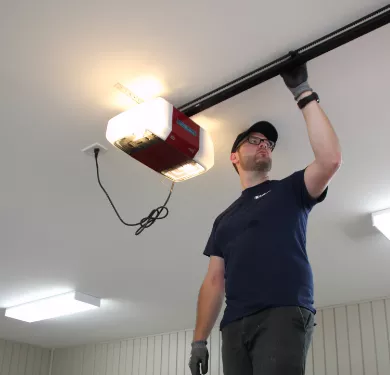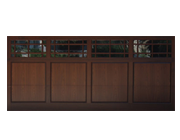Maintenance isn’t something anyone wants to deal with, but it is an important part of life. When it comes to your garage door, making sure everything is in good working order can prevent serious problems down the line. Just like a checkup at the doctor can determine whether there are potential health problems in your future, inspecting your garage door can give you an idea if anything is going wrong early on.
The most heavy and largest object that moves on a regular basis in your home is the garage door. It’s also something you probably use a lot when you leave your home. Providing maintenance can keep you and your family safe when using the garage door.

The safety of your family should always be number one
As heavy as a garage door is, accidents can happen. In fact, many malfunctioning garage doors lead to incidents on an annual basis. As an idea of how serious this issue is, in the United States in 2014, there were more than 18,000 accidents that were linked to someone’s garage door.
So what causes all of these accidents? One of three things in most cases. Some problems are due to the automatic reversal systems not being calibrated properly, whether the mechanical or photoelectric one. The second reason is due to a spring system that is imbalanced and not offering the proper counterweight for the door. The final reason is because of a component that malfunctions in some way.
Choose a precise time when you will inspect the garage door
Most people have an easy way to schedule a reminder on their laptop, smartphone, or tablet. This is the perfect option for setting up a schedule to inspect your garage door. Set up two different times each year when you will do so. You won’t need to schedule more than a half‑hour or so each time.
So what does an inspection actually entail? You are going to want to lubricate all of the metal parts, visually inspect certain parts of the garage door system, and run a safety check on the automatic reversal systems if you happen to use an electric garage door opener.
What you need to do during your inspection
Now that you are ready to make sure your garage door system is in great shape the entire year‑round, we want to share the exact steps you will need to take. You should do an inspection at least give a year, but if you are in the habit of using the garage more than four times a day (one open and one close included), you may want to do so as often as four times a year. The best time to inspect the door is when the weather is just getting cold and then at the beginning of spring.
Steps for a visual inspection
- Sure, you want to inspect things visually but also use your ears. Open and close the garage door and see if anything sounds strange or louder than usual.
- Take a look the lifting cables which you will find right next to the vertical tracks. Do they look good or are they starting to fray? Check out the drum where the cable is wound and see if things seem aligned as they should be.
- Next, you want to look at the spring system. It is going to be one of two types:
- Extension: this spring system type is located above the horizontal tracks
- Torsion: this system is going to be over the bar and inside of a steel tube
- Does everything look in good shape? Nothing seems about to break? No noises that are strange?
- The next place you want to look is at the rollers. Check for any rollers that might be sliding rather than rolling in the way they are supposed to.
- Check the bolts to be sure they are tightened properly. Look at the brackets where the lift cables are attached and gauge their condition. Make sure to also check the hinges for issues.
- The next spot to look is the bottom of the door and the external frame for the weatherstripping. If these seem frayed or worn down, that can be an issue. Make sure that the weatherstripping doesn’t let in small pests or air.
- Do you have a garage door opener? If it has a photoelectric reversal system equipped, make certain it isn’t covered in dust or dirt.

How‑tos for lubrication
- Two different types of lubricants are required for your garage door. A 5W30 car engine oil or something similar is what you want to use for any metal components. Lubricant made of silicone should be used on weatherstripping on the exterior frame, the bottom of the door, and between sections of the door. Both of these special lubricants can be bought at B & M Garage Door. No matter what type of lubrication you are doing, make sure you clean everything before you start lubricating the important parts. You should also clean up any oil or grease that you have applied in the past.

- Metal parts to lubricate:
- Make sure to lubricate the spring system using a small amount of oil; whatever is left can be wiped up with a clean cloth
- Add a bit of oil on the ball bearings to lubricate the rollers
- A small amount of oil should be placed at the junction on the hinges
- When it comes to the tracks, just apply a bit of oil to the horizontal track as well as the track curve
- Lubricating the weatherstripping
- For the exterior frame, add lubrication all along the interior side of the weatherstripping
- As far as the door sections go, apply lubricant along the full length; this is especially important if the weatherstripping is made of PVC
- When lubricating the bottom of the door, make sure to get the U‑shaped weatherstripping; this will prevent it from getting stuck to the door threshold
- Carrying out safety test
- The most crucial thing to safety test are the two automatic reverse systems located on your garage door opener. Many door opener manufacturers suggest that you do this more often and may want you to carry out safety testing once a month.
- For your first test, you are checking the mechanical reversal system. What you want to do is take a large piece of wood like a 2’ x 4’ and place it under the open garage door on the threshold. Now try to close the door. When the door touches the piece of wood you place, it should reverse directions and open up again.
- Your next test is of the photoelectric reversal system and is simple to carry out. Use your garage door opener remote to close the door while you place a foot in the way of one of the photo eyes that are found about four to six inches from the ground on the side of the garage door. This should create a situation where the light beam is broken, and the motor will reverse the door.
- Do either of these automatic reversal systems not work the way they are supposed to? This means your garage door system is unsafe and you should immediately get in touch with B & M Garage Door.

Just taking a little bit of time for annual maintenance on your garage door can make it last longer and prevent problems down the road. You also are less likely to run into surprises if you do end up needing to bring in a garage door technician later.
Do you want someone else to take care of it for you?
Some people are so busy that the idea of another chore on the to‑do list is too much. If that’s the case for you or you simply prefer to have an expert to help, we can help. You can contact us at 905-569-9133 (Mississauga) or 905- 873-4848 (Georgetown). We are happy to offer a tune‑up service for a competitive price.
Ready to swap out your entire garage door system? We can send you a quote by email.








Add new comment